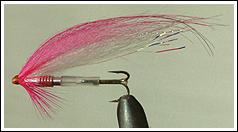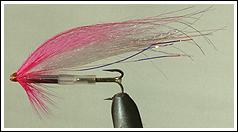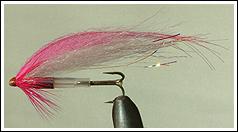| As so often happens, a new idea
appears absolutely suddenly. It can just pop out of nowhere, like the devil from the
tobacco box, and with no apparent reason. One of my net correspondents tried to tie
tube-fly using Mörrum tubes in an untraditional sequence. And what could have been a
mistake turns out to be the creation of an Interchangeable Body Tube System (or if you
prefer, 'I-Bits'), which opens quite a wide range of options allowing you to vary the
weight and colour of fly body. When
you tie tube-fly using The Fly Co. tubes in the "traditional" way, you end up
with a single fly, a fixed body size, weight and combination of colours in wing and body.
If, for instance, I simply want to combine only 5 different colour schemes with 4
different wing lengths, say 3.0-3.5, 5.0-5.5, 7.0-8.0 and 10-12 cm, I will be forced to
buy 20 sets of metal body parts and plastic tubes.
Now if, in addition, I want 5 different
colours of metal tubes for each of the preceding colour combinations and wing lengths, it
brings the total amount of flies to 100. Today, the market offers US and Low water type
short cylinder tubes in many sorts of colours. Knowing the importance of body weight, I
might like to vary the weight of my flies, which would force me to tie at least 500
flies. Then please consider that the normal fly-fisherman never goes fishing with
only one fly - as a successful fly can get lost with a fish, hung on a tree or sadly
dragged to the bottom - but generally carries at least two flies of each type in his
fly-box. It looks like I would be forced to buy off half the stock of materials at the
nearest fly-fishing shop, and need to spend my winter evenings tying something like 1000
flies!!! I am not sure that even professional tiers could afford this...

A fresh runner from Pana river taken on
Black Rainbow IBS fly
So, what should a fly-fisherman do if he
wants to be sufficiently equipped with a broad range of flies to meet different and
varying circumstances, but at the same time doesn't want to spend a huge amount of money
and free time tying thousands of flies?
Last year, one of my online friends asked me to bring a pack of standard brass Morrum
tubes to Russia for him to try. We hadn't discussed much just how to tie flies on such
tubes, because each pack comes with a leaflet with simple instructions in English and I
actually couldn't see any obstacles or potential difficulties. Which just shows how wrong
you can be!
As my friend couldn't read English, he
tried it his way. First, he tied wing on plastic insertion, and then set a metal part as
it should be and secured it from behind with a piece of silicone tubing. We discussed the
sequence of tying on one of the Russian web sites, and when I discovered his
"mistake", I helped make it clear how you normally tie on these tubes,
describing the correct way without paying much attention to his method.

|

|

The same fly with three different bodies;
Pinky IBS
|
Only later, sitting with
my vice and playing with materials, I had the impulse to check out his sequence to see if
it would actually be easier to do, or to add some new elements. There were many different
tubes lying in front of me on my tying board. It suddenly struck me that many of them
could be set on the same fly, making it different from case to case. The
"Interchangeable Body Tube System" was born!
Some fishers may think such patterns are
too simple to fish. Nevertheless, it has shown good results all around Scandinavia, Kola
peninsula and Kamchatka. For each wing attached to the plastic insert, I combined a few
different metal bodies, according to my own idea of how the fly should look. This method
gives you the option to use free swinging or fixed hooks, as you please. You just need to
bring a stock of silicone tubing in different lengths along with you on your fishing
trips.

Kolpakova Rainbow taken on Pinky IBS fly
Each "Interchangeable Body Set"
includes a certain type of body in different combinations. This allows me to meet most
situations I might encounter on the river bank, such as changes in water temperature and
colour, changes in light (sunny or gloomy weather, mid-day or sunset/sunrise hours),
different current speeds, and so on. I think the system may prove specially useful in
those unpredictable days of spring and autumn when weather changes play a really crucial
role and a change in how you present your fly makes all the difference. On early patterns
I used usual front hackle made from cock, but later realised that hackle made from dubbed
rabbit hair turned to be more sufficient and easier to handle on this type of flies.

Fresh Kolpakova Silver salmon taken on
Pinky IBS silver Long Range
Now, a very simple example will show how
important the colour of the body can be in Half-incher flies. Two years ago, I went
fishing with a friend on Mörrum. Since we have often tied flies together and exchanged
ideas, our fly-boxes are pretty similar, but... You may have noticed that almost every
tier wants to have something new to try without saying anything before he sees the
results, and my friend wasn’t an exception. He had tied a well-known Mörrum
pattern, just changing the colour of the body from black to silver. The prize for this
innovation turned out to be a bright fresh runner over 17 kg and the third place in
the Mörrum league. Well, as we Russians like to say: though you may live a century,
you'll never stop learning!
I hope you will find the method as
interesting as I have.
More examples of IBS flies:
Black and Red IBS
Black Rainbow IBS
Rusty Green IBS
P.s. Flies were checked out on river Pana
(Kola peninsula) at the beginning of June 2002 and on river Kolpakova (Kamchatka) at
middle of Sptember 2002.
Jurij Shumakov © 2003
|